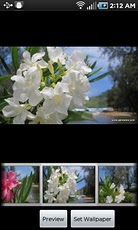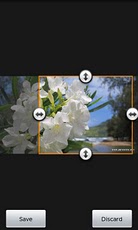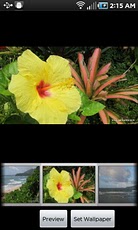The description of Kauai Flowers Pro
Browse over seventy custom high resolution flower pictures take on the Hawaiian garden island of Kauai. Use the preview button to crop the picture to your liking then exit back to home screen and take a look. After ten seconds the Kauai flower app will reappear and you can preview again or make yo... see more
Browse over seventy custom high resolution flower pictures take on the Hawaiian garden island of Kauai. Use the preview button to crop the picture to your liking then exit back to home screen and take a look. After ten seconds the Kauai flower app will reappear and you can preview again or make your final selection with the set wallpaper button.
About Kauai via Wikipedia:
Kauaʻi or Kauai[3] ( /ˈkaʊ.aɪ/; Hawaiian: [kɔuˈwɐʔi]), known as Tauaʻi in the ancient Kaua'i dialect, is geologically the oldest of the main Hawaiian Islands. With an area of 562.3 square miles (1,456.4 km2), it is the fourth largest of the main islands in the Hawaiian archipelago, and the 21st largest island in the United States.[4] Known also as the
"Garden Isle", Kauaʻi lies 105 miles (170 km) across the Kauaʻi Channel, northwest of Oʻahu. This island is the site of Waimea Canyon State Park.
The United States Census Bureau defines Kauaʻi as Census Tracts 401 through 409 of Kauaʻi County, Hawaiʻi, which is all of the county except for the islands of Kaʻula, Lehua, and Niʻihau. The 2000 census population of Kauaʻi (the island) was 58,303.[5]
Native Hawaiian tradition indicates the name's origin in the legend of Hawaiʻiloa — the Polynesian navigator attributed with discovery of the Hawaiian Islands. The story relates how he named the island of Kauaʻi after a favorite son; therefore a possible translation of Kauaʻi is "place around the neck", meaning how a father would carry a favorite
child. Another possible translation is "food season."[6]
Kauaʻi was known for its distinct dialect of the Hawaiian language before it went extinct there. Whereas the standard language today is based on the dialect of Hawaiʻi island, which has the sound [k] at the beginning of words, the Kauaʻi dialect was known for pronouncing this as [t]. In effect, Kauaʻi dialect retained the old pan-Polynesian /t/,
while 'standard' Hawaiʻi dialect has innovated and changed it to the [k]. Therefore, the native name for Kauaʻi was Tauaʻi, and the major settlement of Kapaʻa would have been called Tapaʻa.
Kauaʻi's origins are volcanic, the island having been formed by the passage of the Pacific plate over the Hawaii hotspot. At approximately six million years old, it is the oldest of the main islands. The highest peak on this mountainous island is Kawaikini at 5,243 feet (1,598 m).[7] The second highest peak is Mount Waiʻaleʻale near the center of the island, 5,148 feet (1,569 m) above sea level. One of the
wettest spots on earth, with an annual average rainfall of 460 inches (1,200 cm), is located on the east side of Mount Waiʻaleʻale. The high annual rainfall has eroded deep valleys in the central mountains, carving out canyons with many scenic waterfalls. On the west side of the island, Waimea town is located at the mouth of the Waimea River, whose flow formed Waimea Canyon, one of the world's most scenic canyons, and which is part of Waimea Canyon State Park. At 3,000 feet (914 m) deep, Waimea Canyon is often referred to as "The Grand Canyon of the Pacific". The Na Pali Coast is a center for recreation in a wild setting, including kayaking past the beaches, or hiking on the trail along the coastal cliffs.
In 1778, Captain James Cook came to Waimea Bay and discovered the “Sandwich Isles,” after the Earl of Sandwich, and in this way introduced Hawaii to Europe.
During the reign of King Kamehameha, the islands of Kauaʻi and Niʻihau were the last Hawaiian Islands to join his Kingdom of Hawaiʻi. Their ruler, Kaumualiʻi, resisted Kamehameha for years. King Kamehameha twice prepared a huge armada of ships and canoes to take the islands by force and twice failed; once due to a storm, and once due to an epidemic. In the face of the threat of a further invasion, however, Kaumualiʻi decided to join the kingdom without bloodshed, and became Kamehameha's vassal in 1810, ceding the island to the Kingdom of Hawaiʻi upon his death in 1824.







